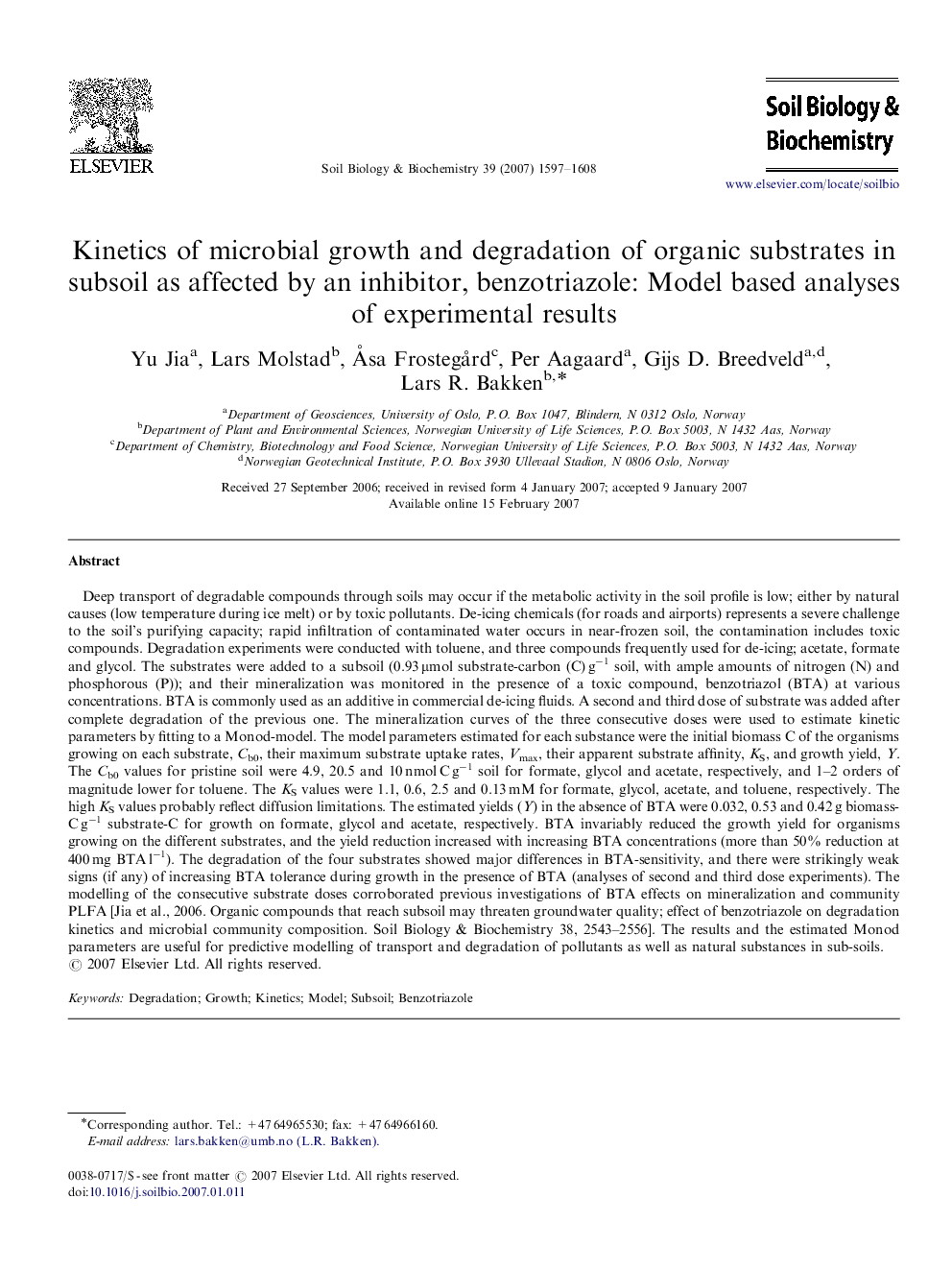| کد مقاله | کد نشریه | سال انتشار | مقاله انگلیسی | نسخه تمام متن |
|---|---|---|---|---|
| 2026224 | 1070023 | 2007 | 12 صفحه PDF | دانلود رایگان |
عنوان انگلیسی مقاله ISI
Kinetics of microbial growth and degradation of organic substrates in subsoil as affected by an inhibitor, benzotriazole: Model based analyses of experimental results
دانلود مقاله + سفارش ترجمه
دانلود مقاله ISI انگلیسی
رایگان برای ایرانیان
کلمات کلیدی
موضوعات مرتبط
علوم زیستی و بیوفناوری
علوم کشاورزی و بیولوژیک
دانش خاک شناسی
پیش نمایش صفحه اول مقاله

چکیده انگلیسی
Deep transport of degradable compounds through soils may occur if the metabolic activity in the soil profile is low; either by natural causes (low temperature during ice melt) or by toxic pollutants. De-icing chemicals (for roads and airports) represents a severe challenge to the soil's purifying capacity; rapid infiltration of contaminated water occurs in near-frozen soil, the contamination includes toxic compounds. Degradation experiments were conducted with toluene, and three compounds frequently used for de-icing; acetate, formate and glycol. The substrates were added to a subsoil (0.93 μmol substrate-carbon (C) gâ1 soil, with ample amounts of nitrogen (N) and phosphorous (P)); and their mineralization was monitored in the presence of a toxic compound, benzotriazol (BTA) at various concentrations. BTA is commonly used as an additive in commercial de-icing fluids. A second and third dose of substrate was added after complete degradation of the previous one. The mineralization curves of the three consecutive doses were used to estimate kinetic parameters by fitting to a Monod-model. The model parameters estimated for each substance were the initial biomass C of the organisms growing on each substrate, Cb0, their maximum substrate uptake rates, Vmax, their apparent substrate affinity, KS, and growth yield, Y. The Cb0 values for pristine soil were 4.9, 20.5 and 10 nmol C gâ1 soil for formate, glycol and acetate, respectively, and 1-2 orders of magnitude lower for toluene. The KS values were 1.1, 0.6, 2.5 and 0.13 mM for formate, glycol, acetate, and toluene, respectively. The high KS values probably reflect diffusion limitations. The estimated yields (Y) in the absence of BTA were 0.032, 0.53 and 0.42 g biomass-C gâ1 substrate-C for growth on formate, glycol and acetate, respectively. BTA invariably reduced the growth yield for organisms growing on the different substrates, and the yield reduction increased with increasing BTA concentrations (more than 50% reduction at 400 mg BTA lâ1). The degradation of the four substrates showed major differences in BTA-sensitivity, and there were strikingly weak signs (if any) of increasing BTA tolerance during growth in the presence of BTA (analyses of second and third dose experiments). The modelling of the consecutive substrate doses corroborated previous investigations of BTA effects on mineralization and community PLFA [Jia et al., 2006. Organic compounds that reach subsoil may threaten groundwater quality; effect of benzotriazole on degradation kinetics and microbial community composition. Soil Biology & Biochemistry 38, 2543-2556]. The results and the estimated Monod parameters are useful for predictive modelling of transport and degradation of pollutants as well as natural substances in sub-soils.
ناشر
Database: Elsevier - ScienceDirect (ساینس دایرکت)
Journal: Soil Biology and Biochemistry - Volume 39, Issue 7, July 2007, Pages 1597-1608
Journal: Soil Biology and Biochemistry - Volume 39, Issue 7, July 2007, Pages 1597-1608
نویسندگان
Yu Jia, Lars Molstad, Ã
sa Frostegård, Per Aagaard, Gijs D. Breedveld, Lars R. Bakken,